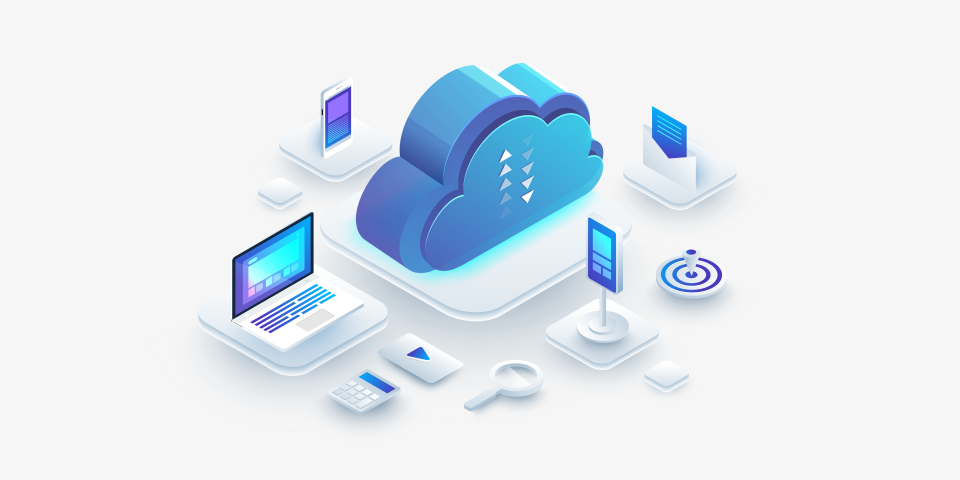- Trends
- May 2021
The top Fintech trends you must know for 2021
What do you get when you fuse financial services with digital technology? Yes, you get FinTech. FinTech implies the application of disruptive technologies by start-ups. These start-ups want seamless products and services like financial management without human error, more manageable mobile payments without compromising time and security, alternative finances for quicker fund procurements, etc.
In the past, when FinTech got introduced, it played a pivotal role in the back-end systems of financial institutions and banks. It has come a long way since then. Today it has made its way to several consumer-oriented applications where customers
- trade stocks
- manage their funds
- pay insurances
- even buy food
This article will focus on how FinTech has made its presence felt in the banking and financial services industry. We will also cover some of the trends that will be prevalent in making this technology mainstream in the years to come. But first, let's dig some more into “FinTech.”
How is FinTech bringing a revolution?
Global FinTech investment more than doubled to $112 billion - Consultancy.eu
FinTech is revolutionizing numerous applications and their usage. FinTech is impacting mobile payment apps, investment applications, and even insurance apps.
Today’s digital era has pushed the current financial services to the customers' palms via their smartphone devices. This has been done to match the ever-growing demand from the customers who are no more content with the traditional financial services industry's services.
Statistics that prove FinTech’s impact
- A third of consumers worldwide are using two or more fintech services – CNBC
- The global Fintech market reached a value of nearly $111,240.5 million in 2019
- 77% of traditional financial institutions plan to increase their focus on innovations to boost customer retention
- The global financial sector is expected to be worth US$26.5 trillion in 2022, with a CAGR of 6%
- 60% of credit unions and 49% of banks in the U.S. believe that fintech partnership is important
- One of the most prominent fintech products is digital payment, which holds 25% of the fintech market
- 60% of consumers want to transact with financial institutions that provide a single platform, such as social media or mobile banking apps
How is FinTech changing the financial industry?
About 1.1 billion unbanked adults worldwide own a mobile phone. - Worldbank
The majority of the customers now use smartphone devices and also access the internet with it. This presents an excellent opportunity for modern banks to provide their financial services tailored to this untapped territory.
This is a crucial juncture where financial institutions can assist the unbanked customer base to access monetary benefits with a few taps on their mobile screen.
Below are top Fintech trends that will drive the industry forward
Let us look at the various technological trends that will make their presence felt in shaping the FinTech industry.
1. Neobanking to make banking accessible

Neobanking has revolutionized modern business and has made an impact in the banking sector as well.
The development in the computerized banking area is providing better options consistently to the consumers. In an assorted list of upcoming applications and dynamic trends, Neobanking is the one coming out on top.
Neo banks have changed the financial scene by focusing on the customer loyalty factor. Many fintech services have already started restructuring their business process.
Convenience and seamlessness are some of the factors that are contributing towards the increasing popularity of Neobanking.
What is Neobank?
A neobank is a virtual bank without any physical branch or a brick-and-mortar structure in layman's terms. It is entirely online, providing banking services to its customers through secure and intelligent mobile apps.
Plus, neobanks are a better option for a world where banking institutions want to keep their customers safe and apart from each other, keeping the Covid-19 situation in mind. In a business sense, neobanks have lesser operational costs as there is no need for managing staff or physical branches. The processing is faster and is integrated with the credit history of the customer.
The financial services that neobanks offer include:
- Opening of bank accounts
- Making online payment
- Enabling faster and secure transfer of funds
- Providing loans at competitive interest rates
Along with that, many neobanks are including chatbots and AI for
- more immediate analysis of customers’ financial patterns
- credit history
- other critical data for creating realistic data models
All the information enables neobanks to personalize their financial services to the customers based on their spending patterns and lifestyle.
There is a boost in the digital banking sector that can be accredited to the growing comfort customers enjoy while transacting digitally. The successful integration between technology and banking services is bringing tremendous revolution to the banking industry, making it more customer-centric.
2. Big data analytics for re-tasking customer data

Increasing developments in big data will allow it to be used in a more sophisticated manner. The result can be compared to when data management platforms allowed the advertisement industry to target their customers by using real-time business intelligence.
As the financial sector is one of the most data-intensive industries, big data analysis will allow banking institutions to adapt to dynamic customer behavior and counter the ever-increasing competition. This is why financial institutions should start re-tasking their customer data.
3. Blockchain to democratize finance

48% of banking executives believe new technologies like blockchain and artificial intelligence (AI) will significantly impact banking through 2020. - Business Insider Intelligence
Blockchain is going to be one of the essential factors in reshaping the financial sector. Blockchain technology will play a vital role in decentralizing the financing industry or democratizing it.
Blockchain has already been used for developing P2P (peer to peer) financing platforms. It is a kind of distributed ledger technology without central data storage. Blockchain was used for the crypto revolution for over ten years, and it is expected to bring more such disruptions in the future.
4. Artificial Intelligence (AI) to save operational costs

More than $1 trillion of our financial services cost structure could be replaced by AI and machine learning (ML) algorithms. - The Financial Band
As per Autonomous in their 84-page report, traditional financial institutions will save 22% costs with the help of AI. This is how they have broken down the saving:
$490 billion savings in the front office
Around $199 billion will be saved by reducing branch network scaling cost, security, tellers, cashiers, and other distribution staff.
$350 billion in savings in the middle office
Applying AI to compliance, KYC/AML, authentication, and other data processing forms will save banks and credit unions a staggering $217 billion.
$200 billion savings in the back office
$31 billion of this will be attributed to underwriting and collections systems.
AI will also open up opportunities for conversational banking for the financial sector. Right now, this is being used by
- Morgan Stanley
- The Bank of America
- JPMorgan
- HSBC, etc
Integrating financial data and account action with software agents will enable chatbots to create more meaningful conversations with customers.
5. Reg-tech for better regulations

RegTech, aka Regulatory technology, helps financial institutions meet and work in compliance with the industry's rules. Automate and digitize anti-money laundering (AML) regulations for countering illegally obtained income and Know Your Customer (KYC) processes to identify and verify the clients to prevent fraud.
Banking institutes will require the help of new technological solutions for improving and streamlining regulatory processes. The intervention of biometric authentication or fingerprint scanning for financial transactions resulted from data theft in 2015.
As per recent research, the market size is continually growing, and over 2.6 billion biometric users will be in the payments market in 2023.
6. Cloud computing to ease banking processes

Cloud has created a name for itself, being comfortable, accessible, and secure. It will dominate the infrastructure model race and will play a vital role in the financing sector as banks utilize cloud-based computing for the business process.
Many financial institutions currently use cloud-based software-as-a-service (SaaS) applications for ‘point solutions,’ especially to carry out KYC verification and enhanced security analytics. In the future, the offerings of applications will increase, making it easier for C-suite executives to make the most from their marketing opportunities. The core service infrastructures that will become necessary utilities due to industry disruptions are
- credit scoring
- consumer payments
- statements
- billings for asset managers’ basic current account functions
FinTech’s launches are now cloud-native, assuring that the teams that use these solutions achieve better scalability and agility. This happens due to the time they save from not manually managing the data centers and infrastructure.
7. Cybersecurity

The world banking sector has always been under constant threat from
- identity theft
- fraud
- espionage
- money laundering
Cyber-threats have been a menace in the financial services industry.
In the 2016 global CEO survey, 69% of CEOs in the financial services industry felt somewhat or overly concerned about cyberthreats.
Data breaches and IT crashes have become a recurring anomaly in banks and have proven to be very costly for the industry.
- TSB’s crash in April 2018 led to a £107 million loss
- Challenger bank Monzo asked 480,000 customers to change their PINs in 2019 due to security concern
- A cyberattack hit a financial institution’s online banking services; the average costs are $1.8 million
Smaller companies incurred the most significant losses due to less investment in IT security. About 71 percent of the adopters of FinTech are concerned regarding its security parameters, yet they favor digital financial products. This is a positive outlook for an industry that is still learning to evolve with technological advancements. For 2021 and beyond, financial institutions will remain committed to investing in more security measures to counter cyber theft.
Some other incredible industry trends that will impact Fintech in 2021
Let’s take a look at the various other Fintech industry trends important to know in 2021.
1. Predictive data analytics
Predictive analytics is an AI application that will facilitate banks to optimize their processes while simultaneously reducing cost and resources. Here's how banking institutions will benefit by applying predictive analytics:
- Fraud detection and False positive reduction: Banks can use predictive analytics to pick up on the tiniest anomalies in transactions for determining their legitimacy
- Managing credit card default risk: With predictive analytics, banks can use historical data to adjudge if a credit card holder will pay back their debts or not.
- Modeling customer lifetime value: Predictive analytics models can forecast the net profit between a customer and the bank.
2. AI will elevate risk management
Traditional methods for checking credibility were based on surveys done on focused groups and often lacked to reflect the real situation. Artificial Intelligence is a game-changer for risk management in finance. The technology enables banking institutions and credit unions with useful tools and solutions for identifying potential risks and fraud.
When a financial institution has the need of handling and evaluating unstructured data artificial intelligence and risk management are the perfect fusion.
Risk managers of financial institutions will focus on analytics and stopping losses in a proactive manner based on AI findings.
AI solutions support financial institutions with trusted and timely data. This data helps them build competence around their customer intelligence.
3. Advanced analytics for operations in banking
Financial institutions are looking to incorporate the latest technology to beat the rising list of competitors. Disruptive technologies are enabling banking and financial institutions to grow to their full potential. Banks are already making strides in their analytics capabilities. They are tapping into untouched data sets for gaining actionable insights and have more accurate decision-making.
Banks can use advanced analytics for the following:
- Operational risk dashboard
Banks can get a web-based view of the risk exposures to the client with an operational risk dashboard. The solution leverages descriptive analytics for providing the latest insights into risk data.
- Forensic analytics
Banks and finance organizations can learn, understand and analyse fraud transactions for developing trends, patterns and other parameters.
- Predictive maintenance
Merging advanced analytics, machine learning and predictive models can help in detecting operational failures of bank system including ATMs. This allows banks to better manage their maintenance staff and reduce their operational expenses.
Application screening
With big data applications, banks can create an efficient screening system. By using predictive modeling and machine learning techniques, banks can create a model that decides the status of customer application by predicting whether the customer will default or not.
4. Personalization in banking
Front-office uses of AI had the potential to save the banking industry an estimated $199 billion by 2023. - Business Insider
When we talk personalization, we cannot keep machine learning and artificial intelligence away. The banking and financial sector keep feeling the regular jolts from technological disruption. With online-only banks and other money lending apps making their way into the market, the playing field is now getting levelled.
The modern digital banking institutes use personalization in the best possible way for delivering better customer experience. Traditional banks too can use the same tools for providing the same customer experience to their customers.
AI enabled smart assistance can help banks to provide customers with suggestions and packages based on their traditional data. The same tools and technologies can be used for tailoring offers bunch other attractive offers for the customers.
Concluding thoughts: Disruptive technologies will support the revolution in the FinTech industry
Many a time, options can be overwhelming, so are the miscalculated steps that you might take. We are talking about the tremendous loss you might incur if any ill-fated cyber-attacks occur over your infrastructure.
The goal of this article was to showcase the available technologies which are enabling banking institutions to create
- a secure business processes
- provide seamless services to their customers
- profile the data collected from their customers
- utilize relevant information
- segregate the said information and develop tailored services
Rapidops is the right digital partner for pushing your traditional or legacy system’s boundaries. We can help you inculcate AI, ML, predictive data analytics, and other disruptive technologies into your business process. We have partnered with clients globally, creating remarkable digital products that have helped banks create useful applications for creating
- customer spending profile
- fraud alert
- repayment schedule based on financial profiling
- avert money laundering instances
Our continuous work toward converting ideas into well-liked and well-crafted apps enables our esteemed clients to make the most of their business opportunities. If you are looking for a digital product development consultant that offers high-quality engineering with proven expertise, and commitment towards your success, then let’s chat.



